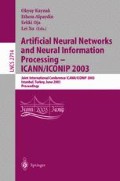Abstract
This paper introduces a new method to model differentiation of biologically plausible neurons, introducing the capability for indirectly defining the characteristics for a network of spiking neurons. Due to its biological plausibility and greater potential for computational power, a spiking neuron model is employed as the basic functional unit in our system. The method for designing the architecture (network design, communication structure, and neuron functionality) for networks of spiking neurons has been purely a manual process. In this paper, we propose a new design for the differentiation of a network of spiking neurons, such that these networks can be indirectly specified, thus enabling a method for the automatic creation of a network for a predetermined function. In this manner, the difficulties associated with the manual creation of these networks are overcome, and opportunity is provided for the utilization of these networks more readily for applications. Thus, this paper provides a new method for indirectly constructing these powerful networks, such as could be easily linked to an evolutionary system or other optimization algorithm.
Access this chapter
Tax calculation will be finalised at checkout
Purchases are for personal use only
Preview
Unable to display preview. Download preview PDF.
References
Billard, A., Ijspeert, A. J., “Biologically inspired neural controllers for motor control in a quadruped robot”, Robotics Laboratory, University of Southern California, SAL 230, Los Angeles 90089, U.S.A 2001.
Berthouze, L., “An episodic memory model using spiking neurons”, Proceeding of the IEEE International Conference on Systems, Man, and Cybernetics, Nashville, TN, pp. 86–91, 2000.
Champbell, S., and Wang, D., Synchronization and Desynchronization in a Network of Locally Coupled Wilson-Cowan Oscillators, IEEE Trans. on Neural Networks 7(3), 1996, 541–552.
Choe, Yoonsuck. Perceptual Grouping in a Self-Organizing Map of Spiking Neurons. PhD thesis, Department of Computer Sciences, The University of Texas at Austin, Austin, TX, 2001.
Choe, Yoonsuck; Miikkulainen, Risto; and Cormack, Lawrence K., “Effects of presynaptic and postsynaptic resource redistribution in Hebbian weight adaptation”, Neurocomputing, vol. 32–33, pp. 77–82, 2000.
Gabbini, F. and Kock, C., “Principles of Spike Train Analysis”, in Kock, C and Segev, I. Editors, Methods in Neural Modeling, MIT Press, pps 313–360, 1999.
Girosi, F., Poggio, T, “Networks and the best approximation property”, Biological Cybernetics, vol. 63, pp 169–176, 1990.
Henkel, Rolf, “Synchronization, Coherence-Detection and Three-Dimensional Vision”, 2000.
Hodgkin, A. L. and Huxley, A. F. (1952) “A Quantitative Description of Membrane Current and its Application to Conduction and Excitation in Nerve” Journal of Physiology 117: 500–544
Hopfield, J. J., and Brody, C., “What is a moment? “Cortical” sensory integration over a brief interval, “Proc Natl Acad Sci. USA, vol. 97(25, pgs 13919–24, 2000.
Hopfield, J. J., and Brody, C., “What is a moment? Transient synchrony as a collective mechanism for spatiotemporal integration,” Proc Natl Acad Sci. USA, vol. 98(3), pg 1282–7, 2001.
Hoppensteadt, Frank C., An Introduction to the Mathematics of Neurons, Second Edition: Modeling in the Frequency Domain, Cambridge University Press, 1997.
Horn, D. and Opher, I., 1999. Collective Excitation Phenomena and their Applications. In: Pulsed Neural Networks, Eds: W. Maass and C. B. Bishop, MIT Press, 297–316.
Ijspeert, A.J, “A leaky-integrator neural network for controlling the locomotion of a simulated salamander”, IEEE, 2000.
Labbi A., and Milanese, R. and Bosch, H., “Asymptotic synchronization in networks of locally connected oscillators”, Int. J. of Bifurcation and Chaos, World Scientific, vol. 9, no. 12, pgs. 2279–2284, 1999.
Levitan, Irwin B. and Kaczmarek, Leonard K., The Neuron: Cell and Molecular Biology, Oxford University Press, 1997.
Maass, W. (1997b). Networks of spiking neurons: The third generation of neural network models. Neural Networks, 10 (9):1659–1671.
Malaka, R. and Buck, S., “Solving nonlinear optimization problems using networks of spiking neurons”, International Joint Conference on Neural Networks, 2000.
Michel, Olivier and Biondi, Joelle, “From the chromosome to the neural network”, In Pearson et al. pgs 80–83, 1999
Opher, I., Horn, D., and Quenet, B. Clustering with Spiking Neurons. In Proceedings of the International Conference on Artificial Neural Networks, ICANN’99 Proceedings of the International Conference on Artificial Neural Networks, ICANN’99, Edinburgh, Scotland, September 1999, pp. 485–490.
Rinzel, J. and Ermentrout, B., “Analysis of neural excitability and oscillations”, in Kock, C and Segev, I. Editors, Methods in Neural Modeling, MIT Press, pp. 251–291, 1999.
Ruf, B. and Schmitt, M. (1998). Self-organization of spiking neurons using action potential timing. IEEE Transactions on Neural Networks, 9(3):575–578.
Von der Malsburg, C. and Schneider, W., “A neural cocktail-party processor,” Biol. Cybern., vol. 54, pp. 29–40, 1986.
Author information
Authors and Affiliations
Editor information
Editors and Affiliations
Rights and permissions
Copyright information
© 2003 Springer-Verlag Berlin Heidelberg
About this paper
Cite this paper
Fischer, A.D., Dagli, C.H. (2003). Indirect Differentiation of Function for a Network of Biologically Plausible Neurons. In: Kaynak, O., Alpaydin, E., Oja, E., Xu, L. (eds) Artificial Neural Networks and Neural Information Processing — ICANN/ICONIP 2003. ICANN ICONIP 2003 2003. Lecture Notes in Computer Science, vol 2714. Springer, Berlin, Heidelberg. https://doi.org/10.1007/3-540-44989-2_130
Download citation
DOI: https://doi.org/10.1007/3-540-44989-2_130
Published:
Publisher Name: Springer, Berlin, Heidelberg
Print ISBN: 978-3-540-40408-8
Online ISBN: 978-3-540-44989-8
eBook Packages: Springer Book Archive

